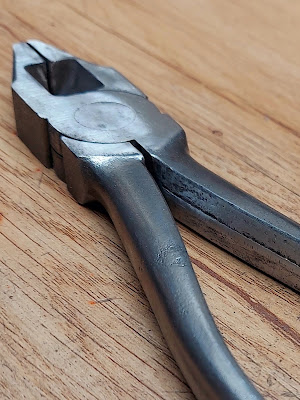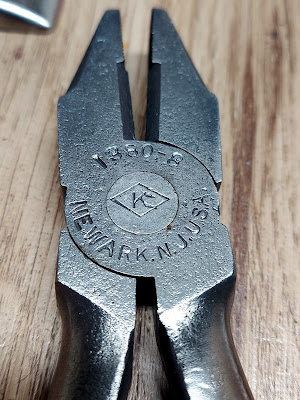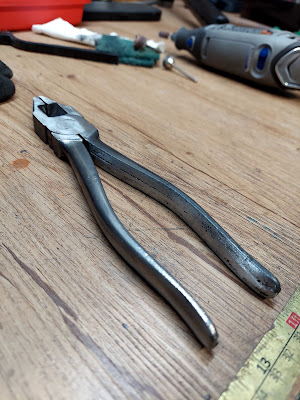Tool Restoration
1380-8 (8 Inch)
Sometimes things just happen out of the blue. Take for instance, those times you might have gone to the market just to grab some chips, but on the way there you ran into a ballgame at the park and spent the next three hours cheering for both team because, well, you really didn't know anyone playing. Fun time had, just out of the blue! I said all that to say today's post is about a tool that came out of the blue! Let's get into it.
What Have We Here?
Last Saturday I made a quick trip to The Tool Box just to take a quick look around. Among a couple other things, I picked up a beautiful pair of linesman pliers. There was very little rust, but they we well-patinaed, and the jaws were in absolutely perfect condition! But the best part was, peeling off the $1.00 price tag revealed these pliers were Kraeuters!
Now, that may not mean much, but Kraeuter tools were the bee's knees in their heyday, and I've always wanted a Kraeuter. The problem was, I was never willing to pay the prices this old brand pulls down in the used tool market. Imagine my glee when I removed that price tag - a pair of Kraeuters - out of the blue!
I am a lineman for the county
And I drive the main road
Searchin' in the sun for another overload
I hear you singing in the wire
I can hear you through the whine
And the Wichita lineman
Is still on the line - Glenn Campbell, Wichita Lineman, 1968
Anyway, these are 8" linesman pliers, the largest in my stable I believe! And, based on the logo and the "Newark, NJ" stamp, and according to internet sources, these pliers are from roughly 1930.
The K-Diamond Line
Let me tell you a little about this company, Oh, and for the sake of transparency, this history of the once-king Kraeuter is derived from the Alloy Artifacts website. Kraeuter & Company was founded by August Kraeuter, a German immigrant who came to America in 1859 at 22 years of age. By 1864 Kraeuter was in the partnership of Heuschkel, Kraeuter & Company, and by 1869 with Foerster & Kraeuter. Finally, in 1878 Kraeuter began his own business manufacturing tools. The company's earliest products were primarily machinists' tools such as calipers.
In 1902 August Kraeuter sold the business to Arthur A. Kraeuter, his eldest son. And by 1939 Kraeuter had introduced the "K- Diamond" line of economy tools, a selection of popular styles produced with simpler finishes to allow lower prices. The 1939 catalog shows that the K-Diamond line had already adopted the circular marking style by that time.
De-Pitting
That title sounds a little like something you'd do with fresh cherries when getting ready (for anyone but me) to bake a pie. But, alas, the only thing really wrong with these pliers was that both faces had some pitting.
Of course this made absolutely no impact on the pliers' ability to function - it was just a matter of aesthetics. But I figured, what the heck. So, on a 20⁰ day I clamped the pliers to the garden bench...
Some of my linesman pliers:
✤ Dad's Linesman Pliers - September 2023
✤ Tool Storage and the Tool Board- October 2021
✤ My Lineman's Pliers- March 2021
✤ Wards Linesman Pliers Refurb - September 2021
⎯⎯⎯⎯⎯⎯⎯⎯⎯⎯⎯⎯⎯⎯⎯⎯⎯
Now, a random post! Yet Another Hallway Detail
And went at both faces with a worn out 40 grit sanding disc in the angle grinder. I was very careful around the logo and the rest of the stamping because I didn't want to remove the ol' Kraeuter identification. That left it with a few remaining pits, but nothing major.
The Final Touch
I mentioned earlier that these pliers were in pretty nice condition, and it was clear the the handles were blued and the bluing was in very nice shape. The only problem is, in my enthusiasm to restore these pliers, the soak in Evaporust and the cleanup after, made the original bluing quite spotty.
So, after a really good cleanup and sanding, I went to the handles with cold-bluing solution and some light oil...
The "hot" process is an alkali salt solution using potassium nitrite or sodium nitrate and sodium hydroxide, referred to as "traditional caustic black", that is typically done at an elevated temperature, 135 to 155 °C (275 to 311 °F). This method was adopted by larger firearm companies for large scale, more economical bluing. It does provide good rust resistance, which is improved with oil. - Wikipedia
While cold-bluing doesn't do quite as nice a job as "hot" bluing, it does a really nice job. The difference is the cold-bluing process only takes a few minutes, while hot-bluing is a whole process.
And just like that, out of the blue, I have a nice looking pair of Kraeuter linesman pliers for $1.00 plus maybe 5¢ worth of cold-bluing solution, so..$1.05! Gotta love it! Hey - thanks for stopping by and..see ya' next time!












